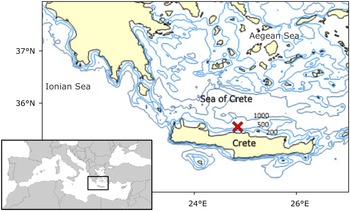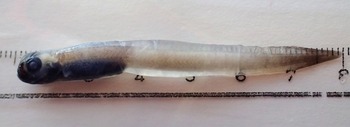Introduction
Atlantic soft pout Melanostigma atlanticum Koefoed, Reference Koefoed1952 of the family Zoarcidae (eelpouts) is a mesopelagic species that inhabits waters between 400 and 1800 m deep on the continental slope (Andriashev, Reference Andriashev, Whitehead, Bauchot, Hureau, Nielsen and Tortonese1986). Of the 14 species included in the genus Melanostigma (Orlovskaya and Balushkin, Reference Orlovskaya and Balushkin2020) only M. atlanticum is distributed in the North Atlantic region, specifically from the western north Atlantic (Newfoundland to Cape Hatteras) to the coast of Scotland and the north-western Africa in the east, including the Mediterranean Sea (Orlovskaya and Balushkin, Reference Orlovskaya and Balushkin2020). Three more species of the genus Melanostigma (M. gelatinosum, M. meteori, and M. thalassium sp.) are distributed in the South Atlantic (Orlovskaya and Balushkin, Reference Orlovskaya and Balushkin2019), while all other species are distributed in the Pacific and the Southern Oceans (Orlovskaya and Balushkin, Reference Orlovskaya and Balushkin2020). The first record of M. atlanticum in western Mediterranean waters was found by Tortonese (Reference Tortonese1970) in the Gulf of Genoa at a depth of 450 m. Four new specimens were found in July 1973 off Blanes (Catalan Sea) at a depth of 570 m (Matallanas, Reference Matallanas1975). Several records of M. atlanticum were reported later in the western Mediterranean, commonly below 500–600 m depth (Andriashev, Reference Andriashev, Whitehead, Bauchot, Hureau, Nielsen and Tortonese1986; Quignard and Tomasini, Reference Quignard and Tomasini2000; Massuti et al., Reference Massuti, Gordon, Moranta, Swan, Stefanescu and Merrett2004). In addition, M. atlanticum was only recently discovered in the southern Adriatic Sea, along with other rare species (Ungaro et al., Reference Ungaro, Martino, Strippoli and Marano2002).
The biology of M. atlanticum is poorly known. McAllister and Rees (Reference McAllister and Rees1964) and Andriashev (Reference Andriashev, Whitehead, Bauchot, Hureau, Nielsen and Tortonese1986) describe it as a planktivorous mesopelagic species which lives along the continental slope. It reaches a length of 15 cm, usually 7–11 cm. During the reproductive period, M. atlanticum is known to burrow in soft sediment in groups for egg laying (Silverberg et al., Reference Silverberg, Edenborn, Ouellet and Béland1987; Silverberg and Bossé, Reference Silverberg and Bossé1994). In the Mediterranean, a patchy distribution has been reported for the species, probably related to aggregation during reproduction and to its preference for specific sediments (Dallarés et al., Reference Dallarés, Cartes and Carrassón2021). Low larval dispersion could be a determining factor posing difficulties for colonizing neighbouring habitats.
In this paper, the presence of M. atlanticum is reported for the first time in the eastern Mediterranean basin (Sea of Crete). It is the easternmost confirmed record of the species which extends its distribution range in the Mediterranean Sea eastwards by more than 1000 km.
Materials and methods
During a research trip carried out on 11/12/2019 onboard the R/V PHILIA one specimen of M. atlanticum was collected at a station north of the island of Crete in the south Aegean Sea (Sea of Crete; N 35° 31.810, E 24° 49.510; Figure 1). A pelagic trawl with vertical opening of 7 m, horizontal opening of 12 m and a cod-end mesh size of 8 mm (bar; i.e. 16 mm stretched), was used. The trawl sample was collected during daylight, with a 78 min tow duration. The fishing depth was 683 to 710 m (avg. 698.4 m) while the bottom depth varied from 735 to 769 m (avg. 757.5 m); therefore, the pelagic trawl was constantly towed at an approximate distance of 50 m above the seabed. Sampling was carried out within the framework of the MesoBED project in order to explore the distribution, biological aspects, and the ecological role of mesopelagic fish in Greek seas.

Figure 1. Map of the study area; the station is marked with an X.
Results and discussion
The specimen measured 66.1 mm total length (TL), 53.2 mm standard length (SL), 20 mm preanal length (PL) and its total weight was 0.810 g. It had an eel-like elongated and gelatinous body, with a rounded section, which compressed laterally towards the tail. The body was a translucent, gray-colour with violet hues, which darkened to almost black on the back, on the tip of the tail, snout, and chin. The body lateral line and scales were absent and the eyes were large and round (Figure 2). The internal organs and myomeres were visible and the number of myomeres counted was 95, within the range reported for the species (i.e. 93–99; Orlovskaya and Balushkin, Reference Orlovskaya and Balushkin2019). Five suborbitals pores and there another five mandibular ones were present under the eyes and in the lower jaw respectively, in agreement with the species' original description (Koefoed, Reference Koefoed1952). The head was ovoid and wide, 13% of total length. The pectoral fins (7 rays) were developed, while the pelvic fins were absent. The dorsal and anal fins met at the back of the body and were joined by the tail fin (Figure 2).

Figure 2. The specimen of Melanostigma atlanticum from the Sea of Crete (Total length: 66.1 mm).
Melanostigma atlanticum is the only zoarcid present in the Mediterranean (Dallarés et al., Reference Dallarés, Cartes and Carrassón2021). The specimen matched the description of M. atlanticum provided by Orlovskaya and Balushkin (Reference Orlovskaya and Balushkin2019) and differed from M. thallassium, the only Melanostigma species found in the east (but south) Atlantic and which has a non-transparent body (Orlovskaya and Balushkin, Reference Orlovskaya and Balushkin2019). The specimen is stored in formalin at the labs of the Institute of Marine Biological Resources and Inland Waters (IMBRIW, Athens, Greece).
Although several studies on fish communities have been performed in the eastern Mediterranean, this species had never been caught or reported from this region due to its deepwater habitat (Golani et al., Reference Golani, Ozturk and Basusta2006; Papaconstantinou, Reference Papaconstantinou2014). The presence of M. atlanticum in the eastern part of the Mediterranean Sea proves that the geographical distribution of the species is not restricted to the western part but spreads throughout the basin. We hypothesize that this species is native to deepwater habitats in the eastern Mediterranean, though it may be rare in these waters. The lack of earlier recording of the species in the eastern Mediterranean Sea is likely attributed to its very small size and slender body shape, which helps it easily escape capture by most commercial fishing gears, as well as the limited trawling activity at depths greater than 400 m (Maina et al., Reference Maina, Kavadas, Damalas, Pantazi and Katsanevakis2018). A large number of studies on the fish fauna of the Mediterranean Sea have concentrated in coastal areas and shallower waters, and focused mainly on commercial species, and more extensive research surveys in those deeper areas occupied by meso- and bathypelagic fish fauna will be required to better understand the biodiversity and ecology of the Mediterranean deep-sea fish community (Tsagarakis et al., Reference Tsagarakis, Darmanin, Mabruk, Auriemma, Azzurro, Badouvas, Bakiu, Bariche, Battaglia, Betti, Borme, Cacciamani, Cali, Corsini-Foka, Crocetta, Dalyan, Deidun, Digenis, Domenichetti, Dragičević, Dulčić, Durucan, Guy-Haim, Kesici, Lardi, Manitaras, Michailidis, Piraino, Rizgalla, Siapatis, Soldo, Stipa, Kurt, Tiralongo, Tsiamis, Vella, Vella, Zava and Gerovasileiou2021).
Authors’ contributions
A. Siapatis performed sampling, identified the species, performed measurements and wrote the first draft of this manuscript. K. Markakis performed sampling, identified the species and reviewed the manuscript. K. Tsagarakis acquired funding, performed sampling and measurements and reviewed the manuscript.
Financial support
Sampling was performed in the framework of project MesoBED ‘Mesopelagic fish: Biology, ecological role and distribution of a disregarded trophic link’, funded by the General Secretariat for Research and Innovation (GSRI) and the Hellenic Foundation for Research and Innovation (HFRI), Greece (Project No. 449).
Competing interest
None.
Ethical standards
Not applicable.
Data availability
The authors confirm that the data supporting the findings of this study are available within the article.



